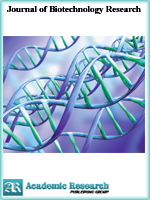Journal of Biotechnology Research
Online ISSN: 2413-3256
Print ISSN: 2413-8878
Print ISSN: 2413-8878
Quarterly Published (4 Issues Per Year)

Archives
Volume 5 Number 8 August 2019
RAPD-Contaminant Indicative Bands Induced by Sodium Lauryl Sulfate of Economic Fish (Sardine Aurita) from Libyan Coasts
Authors: Tito N. Habib ; Mohamed F. El-Sayed ; Fathi M. Ali ; Tawfiq M. Almsatar
Pages: 69-76
DOI: doi.org/10.32861/jbr.58.69.76
Abstract
The presence of sodium Lauryl sulfates (SLS) as synthetic detergents, in marine environment arises mainly from its presence in complex domestic and industrial effluents as well as its release directly from some applications (e.g., oil dispersants and pesticides). It has been reported that SLS is toxic and affects survival of aquatic animals such as fishes, microbes like yeasts and bacteria. It is also toxic to mammals like mice and humans but to a lesser extent. Many studies have shown that the direct discharge of untreated wastewater into aquatic environment containing anionic surfactants causes significant damage to the aquatic environment due to the growth of algae that consume oxygen needed for the life of aquatic organisms. These damages in the aquatic environment are caused not only by the presence of anionic surfactants (SLS), but also by their interaction with other pollutants in the aquatic environment, which increases their toxic effect on aquatic organisms. Such detergents, however, became a public nuisance because they were neither soluble nor biodegradable. The present study intended to evaluate the fate of SLS as synthetic detergents on Tripoli coastal site of Libya, and quantifying their impacts on fish (Sardine aurita) DNA mutation, compared with other species through literature review. Our results provide functional evidence for genome toxicity of fish, of the DNA mutation caused by detergents effluents. This study provides the rationale for a simple genetic test to identify the impacts of detergents on aquatic ecosystem of Libyan coastal region.
Antibacterial Effects of Aqueous Ethanolic Leaf Extracts of Ocimum gratissimum, Cymbopogon citratus, Vernonia amygdalina and Annona muricata on the Isolated Pathogenic Organism of Citrus Canker from Citrus sinensis (Sweet Orange)
Authors: Eneh Frank Uchenna ; Okeke Chidi Benjamin ; Igbokwe Gabriel Ejike ; Okpala Chukwuemeka Obumneme ; Nwachukwu Godslove Pephel
Pages: 64-68
DOI: doi.org/10.32861/jbr.58.64.68
Abstract
The aqueous ethanolic extracts of Vernonia amygdalina, Ocimum gratissimum, Cymbopogon citrates and Annona muricata were screened for antibacterial activities at 200mg/ml concentration. Antibacterial efficacy of extracts against the bacteria were identified by gram staining techniques, coagulase and catalase tests and the bacterial isolate was indicated by the appearance of clear zones of inhibition around the disks. The extracts of Vernonia amygdalina and Ocimum gratissimum showed inhibitory activities against the bacterial isolate with zones of inhibition of 12mm and 8.5mm respectively while extracts of C.citratus and A.muricata showed no zone of inhibition. Result of the antimicrobial activity of the extracts compared effectively with the activity of standard fumigant with extract of V. amydalina showing the highest potency which was used in preparation of a local fumigant. The minimum inhibitory concentration of V.amygdalina and O.gratissimum were 25mg/ml and 50mg/ml respectively which were not determined in C.citratus and A.muricata. In conclusion, the results of this investigation showed that the aqueous ethanolic leaf extracts of V. amygdalina and O. gratissimum can be used as an effective control measure for the elimination of citrus canker of Citrus sinensis.



